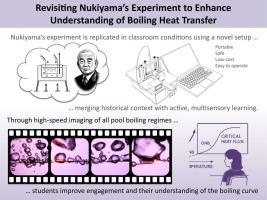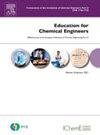重访Nukiyama的实验,加深对沸腾传热的理解
IF 2.3
2区 教育学
Q1 EDUCATION, SCIENTIFIC DISCIPLINES
引用次数: 0
摘要
池沸腾是传热中的一种基本现象,也是许多工业过程中的一个关键方面,特别是在涉及高功率尺寸比的应用中。因此,它是工程传热课程的核心课题。在对其理解的基础性贡献中,Nukiyama的经典实验仍然是一个里程碑,但其教学潜力仍未得到充分利用。对沸腾现象的有效指导得益于将物理洞察力与理论解释结合起来,并辅以适合内容的学习方式。课堂演示在吸引学生和克服概念障碍方面特别有效,而经典实验则为学习增添了历史视角。在这种背景下,一个新的实验装置已经被开发出来,以复制Nukiyama的实验,并已在本科传热课程中实施,以支持理论教学和引入实际的工程相关性。该设备能够在标准教室条件下实现所有沸腾状态和临界点的高速实时可视化。该演示已被证明在提高学生表现、参与和感知学习方面非常有效——强调了动态观察在连接理论概念和物理现象方面的价值。这种方法将历史实验背景与主动学习策略和多感官反馈相结合,为传热教育提供了宝贵的贡献。本文章由计算机程序翻译,如有差异,请以英文原文为准。

Revisiting Nukiyama’s experiment to enhance understanding of boiling heat transfer
Pool boiling is a fundamental phenomenon in heat transfer and a critical aspect in many industrial processes, particularly in applications involving high power-to-size ratios. Consequently, it is a core topic in engineering heat transfer courses. Among the foundational contributions to its understanding, Nukiyama’s classical experiment remains a landmark, yet its didactic potential is still underexploited. Effective instruction on boiling phenomena benefits from combining physical insight with theoretical explanation, supported by learning modalities suited to the content. Classroom demonstrations are particularly effective in engaging students and overcoming conceptual barriers, while classical experiments add a historical perspective to learning. In this context, a novel experimental setup has been developed to replicate Nukiyama’s experiment and has been implemented in undergraduate heat transfer courses to support theoretical instruction and introduce practical engineering correlations. The device enables high-speed, real-time visualization of all boiling regimes and critical points under standard classroom conditions. The demonstration has proven highly effective in improving student performance, engagement, and perceived learning—highlighting the value of dynamic observation in bridging theoretical concepts with physical phenomena. This approach offers a valuable contribution to heat transfer education, combining historical experimental context with active learning strategies and multisensory feedback.
求助全文
通过发布文献求助,成功后即可免费获取论文全文。
去求助
来源期刊

Education for Chemical Engineers
Multiple-
CiteScore
8.80
自引率
17.90%
发文量
30
审稿时长
31 days
期刊介绍:
Education for Chemical Engineers was launched in 2006 with a remit to publisheducation research papers, resource reviews and teaching and learning notes. ECE is targeted at chemical engineering academics and educators, discussing the ongoingchanges and development in chemical engineering education. This international title publishes papers from around the world, creating a global network of chemical engineering academics. Papers demonstrating how educational research results can be applied to chemical engineering education are particularly welcome, as are the accounts of research work that brings new perspectives to established principles, highlighting unsolved problems or indicating direction for future research relevant to chemical engineering education. Core topic areas: -Assessment- Accreditation- Curriculum development and transformation- Design- Diversity- Distance education-- E-learning Entrepreneurship programs- Industry-academic linkages- Benchmarking- Lifelong learning- Multidisciplinary programs- Outreach from kindergarten to high school programs- Student recruitment and retention and transition programs- New technology- Problem-based learning- Social responsibility and professionalism- Teamwork- Web-based learning
 求助内容:
求助内容: 应助结果提醒方式:
应助结果提醒方式:


